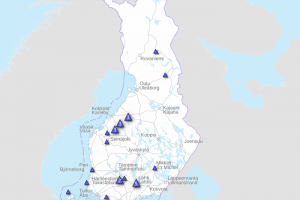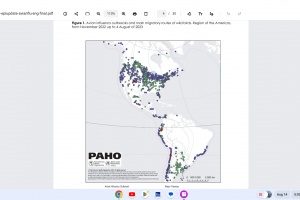Mammals Infected With Bird Flu
Mammals Infected With Bird Flu 2023
Mammalian infections with the highly pathogenic avian influenza (HAPI) virus is a global concern in 2023, according to the U.S. Centers for Disease Control and Prevention (CDC) and the Department of Agriculture (USDA). In addition, the World Health Organization (WHO) Technical report states that HAPI viruses (bird flu) are evolving, and various mammals are at risk. Furthermore, the U.K. Health Security Agency (UKHSA), World Organisation for Animal Health, the European CDC's Communicable Disease Threats Report, and the Pan American Health Organization (PAHO) have confirmed bears, cats, dogs, dolphins, ferrets, foxes, minks, penguins, sea lions, sea seals, elephant seals, skunks, and other mammals had been infected with HAPI viruses in 2022 and 2023.
On November 18, 2023, the CDC Emerging Infectious Diseases Volume 29, Number 12—December 2023, described the pathology of natural infection with highly pathogenic avian influenza A(H5N1) virus of Eurasian lineage Goose/Guangdong clade 2.3.4.4b in 50 red foxes (Vulpes vulpes), six striped skunks (Mephitis mephitis), four raccoons (Procyon lotor), two bobcats (Lynx rufus), 2 Virginia opossums (Didelphis virginiana), one coyote (Canis latrans), one fisher (Pekania pennanti), and 1 gray fox (Urocyon cinereoargenteus). This research confirmed that the genotype analysis indicates that the HAPI cases represent spillover infections from wild birds.
Since the early 1980s, several influenza A virus subtypes, such as A(H10N4), A(H3N2), swH3N2/pH1N1 reassortant, A(H1N2), and A(H9N2), have been shown to spread in mink. Detecting the current predominant A(H5N1) HPAI virus in mammals, including farmed mink, does not change the general health risk for the general public, which the CDC and WHO consider low as of August 2023.
Canada Mammals Infected With Bird Flu
The Canadian Food Inspection Agency (CFIA) is responding to cases of H5N1 HPAI in birds and mammals across Canada. CFIA says the number of documented H5N1 cases in non-avian species is low. However, on April 1, 2023, CFIA confirmed a dog in Oshawa, Ontario, contracted the avian flu and died. The dog was infected with bird flu after chewing on a wild goose. And on August 30, 2022, an H5N1 infection in a black bear was confirmed in Quebec, Canada. In May 2022, two red fox kits in Ontario, Canada, tested positive for HPAI. Those kits were the first reported cases of the current HPAI outbreak in a wild mammal in North America. In addition, HAPI was found in skunks and foxes in Prince Edward Island in 2022, reported the Canadian Wildlife Health Co-operative.
Europe Mammals Infected With Bird Flu
As of July 16, 2023, the WHO reported 29 cats were found to be positive for influenza A (H5N1) in Poland (Gdańsk, Gdynia, Poznań, Lublin, Pruszcz Gdański, Nowy Dwór Mazowiecki, Bydgoszcz, Wrocław, the Rzeszów district and the vicinity of Zamość). Fourteen cats were euthanized, and 11 died, with the last death reported on June 30. Media sources from Poland cite the director of the National Veterinary Institute in Puławy, stating that 'they have detected two mutations that indicate that the A(H5N1) virus is evolving to multiply more easily in mammals'. The European Centre for Disease Prevention and Control (ECDC) reported on July 8, 2023, media sources reported that in Italy (Lombardy region), five dogs and one cat in a poultry farm tested positive for influenza A(H5N1) virus.
On July 18, 2023, bird flu infections were detected in blue foxes in the fur farm in Kausti, Central Ostrobothnia, Finland. On July 20, 2023, the Finnish Food Agency established an infection zone to prevent the further spread of the avian influenza disease.
France reported an outbreak of HAPI among red foxes and gulls northeast of Paris in March 2023. In addition, the HAPI virus infected a cat in France in December 2022. Spain reported in Eurosurveillance on January 19, 2023, a HAPI outbreak occurred on a mink (Neovison vison) farm in Carral in October 2022. This finding shows that the H5N1 strain can spread from one infected mammal to another. Previously, Norway reported H5N1 for the first time in mammals (foxes); according to a study posted on July 25, 2022, and in June 2022, a harbor porpoise became stranded off the west coast of Sweden (58.64817 N, 11.28973 E).
South American Mammals Infected With Bird Flu
Countries in South America have confirmed outbreaks of the HAPI virus in 2023. The detection of HPAI outbreaks in 15 Latin American and Caribbean nations has never been recorded. In response, the PAHO has issued various Epidemiological Alerts. As of epidemiological week #19 of 2023, agricultural authorities in Argentina, Bolivia, Brazil, Canada, Chile, Colombia, Costa Rica, Cuba, Ecuador, Guatemala, Honduras, Mexico, Panama, Peru, Uruguay, Venezuela, and the U.S., have detected HPAI A(H5N1) viruses in domestic birds, farm poultry and/or wild birds, and in mammals.
Argentina: The National Agri-Food Health and Quality Service (Senasa) presented a report on September 15, 2023, regarding HAPI infections in mammals on the Argentine Atlantic coast. On August 10, Senasa confirmed the first case of HPAI H5 in fur seals (Otaria flavescens) on the coast of Tierra del Fuego, near Río Grande. On September 11, the first positive was confirmed in an elephant seal (Mirounga leonina) from the Punta Tombo Natural Reserve, Chubut.
Chile: AFP reported Sernapesca stated in May 2023, more than 7,600 sea lions, 1,186 Humboldt penguins, otters, porpoises, and dolphins had been found dead along Chile's coast. Previously, local media in Chile reported on February 26, 2023, the National Fisheries and Aquaculture Service (Sernapesca) reported a sea lion weighing about 250 kilos with respiratory problems was found on a beach in the northern region of Antofagasta. SERNAPESCA acts concerning the species under its guardianship, corresponding to marine mammals as of June 9, 2023.
Peru: A non-peer-reviewed study reported on March 3, 2023, the complete genomic characterization of HPAI/H5N1 viruses in five species of marine mammals and seabirds (dolphins, sea lions, sanderlings, pelicans, and cormorants) sampled since November 2022. This is the first report of HPAI A/H5N1 in marine birds and mammals from South America, highlighting an urgent need for active local surveillance to manage 40 outbreaks and limit spillover into humans. All Peruvian viruses belong to the HPAI A/H5N1 lineage 2.3.4.4b. Still, they are 4:4 reassortants where 33 genomic segments (PA, HA, NA, and MP) position within the Eurasian lineage that initially entered North America from Eurasia, while the other genomic segments (PB2, PB1, NP, and NS) position within the American lineage (clade C) that was already circulating in North America. Peruvian viruses do not contain PB2 E627K or D701N 37 mutations linked to mammalian host adaptation and enhanced transmission, but at least eight novel, 38 polymorphic sites warrant further examination.
South Korean Mammals Infected With Bird Flu
According to the animal industry report on July 25, 2023, the AI H5 (H5N1) antigen was detected in several cats raised in a cat shelter in Seoul, South Korea. In December 2016, HPAI infection with systemic pathologic lesions was found in cats in South Korea. Genetic analyses indicated that the feline isolates were similar to HPAI H5N6 viruses isolated in chicken farms nearby. The epidemiological role of cats and other pet animal species in transmitting the HPAI H5N1 virus to humans needs continuous consideration and attention.
United Kingdom Mammals Infected With Bird Flu
The U.K.'s Animal and Plant Health Agency reported on March 15, 2023, that dolphins were found dead on beaches in Pembrokeshire, Wales, and Devon, Britain. The BBC reported on February 2, 2023, that the Animal and Plant Health Agency (APHA) had found nine otters and foxes were positive for HPAI H5N1. Cases have been found in Durham, Cheshire, and Cornwall in England; Powys in Wales; Shetland, the Inner Hebrides; and Fife, Scotland (Scottish otters).
The UKHSA published the fourth update on February 1, 2023, Research and analysis - Confirmed findings of influenza of avian origin in non-avian wildlife in England, Scotland, and Wales. In 2022, the U.K. announced it had faced its largest-ever bird flu outbreak, with over 170 cases confirmed since late October 2021. The wild bird risk across Great Brained is medium, and the risk to poultry with stringent bios is low. However, birdkeepers should follow enhanced measures at all times to prevent the risk of future outbreaks.
United States Mammals With Bird Flu
The United States Department of Agriculture (USDA) and the World Animal Health Information System reported over 196 HAPI H5N1 detections in mammals such as striped skunks, black bears, raccoons, red foxes, and seals in 2023. In addition, cats near Thermopolis, WY, Buffalo County, Nebraska, and Oregon were reported with bird flu infections in March/April 2023.
The U.S. Department of Agriculture's National Veterinary Services Laboratories (NVSL) confirmed the first incidence of HPAI in marine mammals on the West Coast on September 8, 2023. Three adult harbor seals in Puget Sound tested positive for the HAPI H5N1 strain. The seals were stranded on Marrowstone Island on August 18 and 25. However, no seal pups have tested positive. Since 2022, H5N1 detections have been reported in harbor and gray seals in Maine.
The NVSL confirmed on March 21, 2023, the presence of HPAI in a striped skunk recovered from Carson County. This is the first documented case of HPAI in mammals in Texas. In Colorado, HPAI was detected in skunks in March 2023. The California Department of Fish and Wildlife received confirmation on February 15, 2023, that an adult bobcat died from the Eurasian strain of HPAI H5N1. The Colorado Parks and Wildlife confirmed on February 9, 2023, several cases of HPAI in free-ranging black bears, skunks, and mountain lions. The Montana Department of Fish, Wildlife, and Parks confirmed on January 17, 2023, three juvenile grizzly bears tested positive for HAPI. In 2022, a fox and a skunk tested positive for HPAI in Montana. The State of Alaska reported on December 13, 2022, that HPAI had been detected in a brown bear cub on Kodiak Island, Alaska. On November 18, 2022, HPAI was seen in a black bear cub in Southeast Alaska. And the University of Florida confirmed a HAPI infection killed a bottlenose dolphin on September 7, 2022. On October 31, 2022, the NVSL confirmed H5N1 HPAI in hunter-harvested blue-winged teal in southwest Louisiana. Additionally, red fox infections were confirmed in Michigan and Minnesota, bald eagles in Alaska, skunks and raccoons in Washington, and seals near Maine in July 2022.
The status of HPAI infections in the Southwest California Condor flock as of July 28, 2023: Total mortality: 21 condors. The APHIS announced on May 16, 2023, that they approved the emergency use of an HPAI vaccine candidate to prevent additional California Condors fatalities. This vaccine clinical trial will use vultures in North Carolina as surrogates. As of July, 13 condors are being vaccinated. As of July 2023, mitigation measures include support of the California Condor Recovery Program. WECAT's conservation plan will support the breeding and rearing of condors at The Peregrine Fund's World Center for Birds of Prey for release into the wild to offset the loss of any adult condors, eggs, or chicks.
Bird Flu Outbreaks
Bird flu (avian influenza) HAPI outbreaks have been confirmed since 2003. Updated news is posted at PrecisionVaccinations.com/BirdFlu.
Bird Flu Vaccines For Humans
Avian influenza (bird flu) vaccines are listed on this web page.
Bird Flu Vaccines for Mammals and Birds
U.S. Agricultural Research Service researchers confirmed on April 14, 2023, that they are currently testing several avian influenza vaccine candidates for use with birds (California Condors) and mammals.





